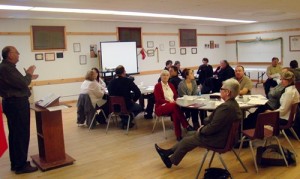Article appeared in the Dec. 15, 2011 issue of the Interlake Spectator…

Fieldstone Ventures Education & Training Centre Inc. held its 14th Annual General Meeting
at the Elks Hall in Ashern on Nov. 29. Among other things, the meeting provided the opportunity to explore how Fieldstone can help the communities it serves address training needs that may have arisen as a result of the flood disaster earlier in the year. Fieldstone’s business manager, Shelley Bjornson believes the training centre has a pivotal role to play in helping the region recover.
To that end, four guests were invited to be a part of a panel to speak on what opportunities they could see arising from the disaster caused by the flood in the West Interlake. Interlake MLA, Tom Nevakshonoff, Ian Phillips, Chief Administrative Officer (CAO) of the RM of Siglunes, Diane Price, the Reeve of the RM of Grahamdale, and Tim Clarke, from Manitoba Agriculture, Food and Rural Initiatives (MAFRI) we all invited.
Nevakshonoff, the first to speak, discussed the flood devastation at length, it’s impact on the communities, the need for compensation for property owners, the need to revamp infrastructure and to work more intelligently than in the past. He expects that the rebuilding process will take about five years.
He highlighted that more carpenters, plumbers, and heavy equipment operators will be needed in order to meet the demands that will inevitably come as the rebuilding occurs, and suggested that Fieldstone Ventures consider offering more training in the trades.
Ian Phillips, CAO of Siglunes, called the flood “a temporary reality”. His focus was on envisioning opportunities to develop Ashern as a service centre for the highway 6 region, in terms of education, recreation and health care services.
“Ashern needs to differentiate itself from other communities and look at its strengths,” said Phillips.
Further, a provincial grant given to flood affected areas will enable Ashern to hire a full-time economic development officer, come January.
He also noted the need for action-oriented, motivated people who will promote the community, as well as the importance of training people from the community.
“If you train them here, then they will stay here,” he said.
Diane Price, Reeve of Grahamdale, was one of several attendees who commended the provincial government on its constant availability during the time of crisis.
“When the flood started I soon learned that all phone calls got a call back. They really seemed to want to work with us,” said Price.
The focus of Price’s discussion was on infrastructure, building new homes, and eventually moving modular homes to permanent sites. She expressed the importance of making sure that residents of Lake St. Martin return, and that the community is rebuilt quickly.
“We don’t want to lose people, because we will lose services,” she said.
Tim Clarke, from Manitoba Agriculture, Food and Rural Initiatives (MAFRI), the last speaker of the evening, gave an agricultural perspective of the flood. He was hesitant to put a positive spin on the flood, since he has dealt closely with farmers who were so severely impacted. However, he identified many job opportunities will come available as farmers work to recover, and stressed the need for people to be trained in order to fill new positions.
Some potential jobs he identified include all of the trades, roofers, landscapers, truckers, heavy equipment operators, custom seeding and spraying service providers, septic field installers, foundation makers, as well as businesses to supply building materials.
Most at the meeting agreed that one major positive development arising out of the disaster is that the municipalities along Hwy 6 have started working together as one large community. The cooperation which was first on drainage issues, has carried over to other joint initiatives, among them a recycling program.
“This flood has brought people together. We are strong,” Bjornson said. “Let’s (continue to) work together as a region.”
Also at the AGM, Fieldstone Vice Chairperson, Merle Klyne, and Bjornson went over the Jun. 30, 2011 Year End Financial Report, and Fieldstone Venture’s Year in Review.
Bjornson reported that all of Fieldstone’s 2010-11 goals have been achieved.
“Fieldstone is doing a lot,” said Klyne. “Not everyone is aware of what and how much.”
Some of the highlights of the past year include hosting a successful career symposium in Ashern, and partnering with educational leaders and post-secondary institutions to bring community based training to the West Interlake area.
Some successful programs have been the Adult Literacy, Interlake Teacher Education, Primary Care Paramedic, Health Care Aide programs, and Intro to Trades with First Nations communities.
Fieldstone Ventures Education and Training Centre continues to be a “one-stop-shop” for adult education and employment, and many new courses are being considered for next year and beyond.
Election of a new Board of Directors also took place at the meeting, with 12 out of 13 seats filled. Positions will be determined at a January, 2012 meeting. The new board received wide community representation, with members from the business, health, political, educational, and Aboriginal quarters.


